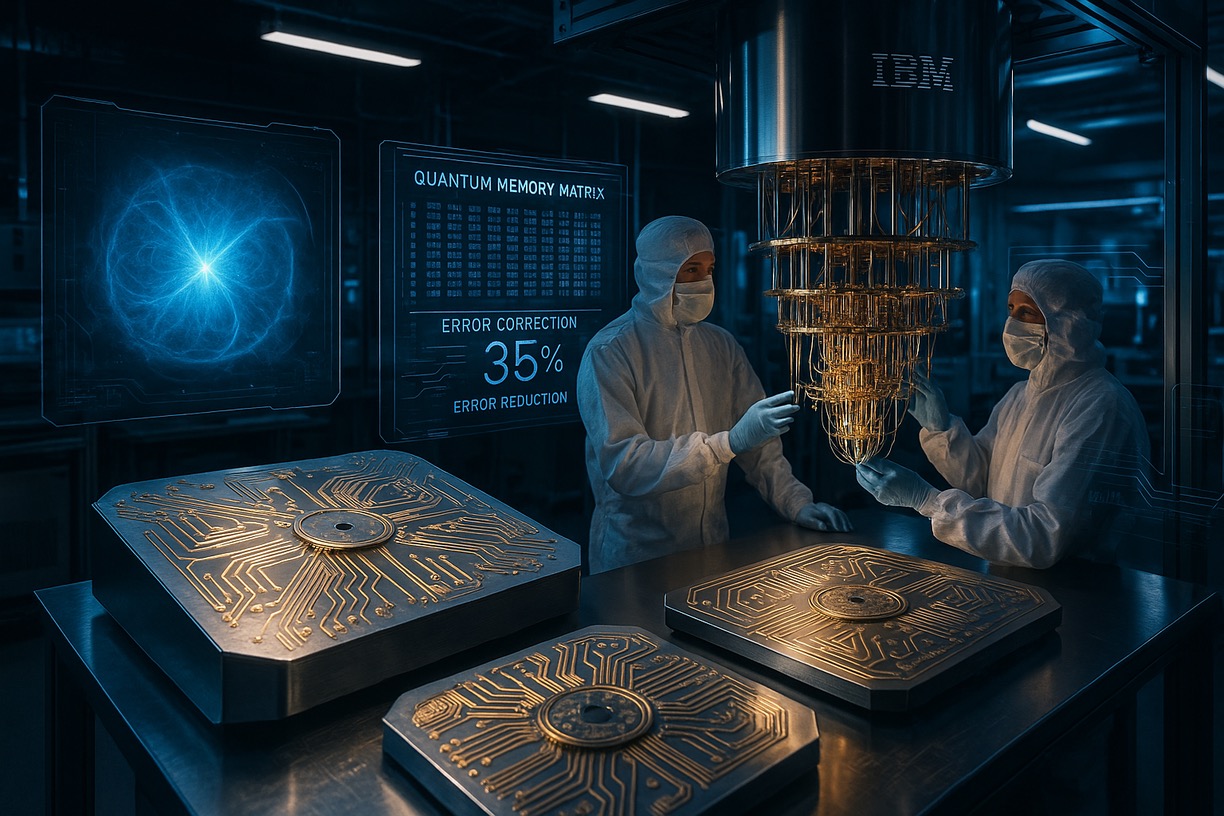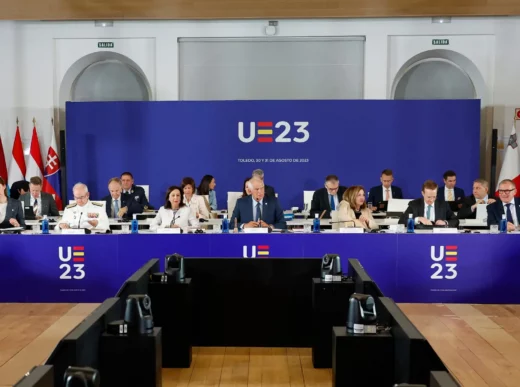The Quantum Leap That Could Rewrite Computing’s Future
On August 14, Terra Quantum
On August 14, Terra Quantum announced a breakthrough that could fundamentally change how we build quantum computers. Their innovation, called QMM-Enhanced Error Correction, doesn’t just incrementally improve existing quantum systems—it introduces an entirely new paradigm that makes quantum computing more practical, more reliable,. And more accessible to industries that have been waiting on the sidelines for the technology to mature.
the implications stretch far beyond the laboratory. While tech giants like IBM, Google, and Microsoft have spent billions trying to scale quantum computing through traditional error correction methods that require thousands of physical qubits to protect just a few logical ones, Terra Quantum has found a way to achieve comparable results with ten times fewer qubits. It’s the difference between needing a warehouse-sized quantum computer and one that could fit in a server room.
Subsequently, 
“We Have Taken A Concept
“We have taken a concept rooted in quantum gravity. And made it plug-and-play for today’s quantum processors. This is a game-changer.”
Meanwhile, — Florian Neukart, Chief Product Officer, Terra Quantum
“While classical computer bits are either 0. Or 1, quantum bits (qubits) exist in a superposition of both states simultaneously—until something disturbs them.”
the problem that has haunted
the problem that has haunted quantum computing
meanwhile, to understand why this breakthrough matters, you need to grasp the fundamental challenge that has plagued quantum computing since its inception: quantum states are incredibly fragile. While classical computer bits are either 0 or 1, quantum bits (qubits) exist in a superposition of both states simultaneously—until something disturbs them. Heat, electromagnetic interference, even cosmic rays can cause quantum decoherence, destroying the delicate calculations that give quantum computers their power.
Current quantum computers are what researchers call NISQ devices—Noisy Intermediate-Scale Quantum processors. They’re noisy because they’re error-prone, intermediate because they’re not yet powerful enough for most practical applications,. And the scale refers to the limited number of qubits they can reliably operate. IBM’s most advanced quantum computer has 1,121 qubits, but maintaining quantum coherence across all of them simultaneously remains extraordinarily difficult.
The traditional solution has been quantum error correction codes, particularly surface codes, which create logical qubits protected by multiple physical qubits. But these methods come with a crushing overhead: you might need 1,000 physical qubits to create one error-corrected logical qubit. For quantum computers to solve real-world problems, they would need millions of physical qubits—a scale that remains years. Or decades away with current technology.
a solution born from cosmic inspiration
in contrast, terra quantum’s approach emerged from an unlikely source: quantum gravity theory. The company’s researchers were exploring how space-time itself might be structured at the quantum level, modeling it as a lattice of finite-dimensional memory cells they called a Quantum Memory Matrix (QMM). What started as theoretical physics research into the nature of reality became the foundation for a practical quantum computing solution.
“The Qmm Concept Models Space-Time
“The QMM concept models space-time as having a memory structure,” explains Dr. Florian Neukart, Terra Quantum’s Chief Product Officer. “We realized we could translate this cosmological idea into a functional quantum circuit that acts like a protective layer for quantum information.”
The breakthrough lies in the elegance of the approach. Instead of requiring complex mid-circuit measurements and feedback loops like traditional error correction, QMM operates as a purely unitary process—meaning it’s reversible. And doesn’t collapse quantum states prematurely. It functions as what Neukart calls a “quantum tensor core,” a compact module that boosts fidelity without increasing circuit depth. Or gate count.
validation on real hardware
the theoretical elegance would mean nothing without practical results, which is why terra quantum’s validation on ibm’s superconducting quantum processors is so significant. In their peer-reviewed paper published in Advanced Quantum Technologies, the researchers demonstrate that a single QMM cycle achieves 73% fidelity—already a substantial improvement over unprotected quantum operations.
But the real power emerges when QMM is combined with simpler error correction methods. When paired with a basic repetition code, logical fidelity jumps to 94%, representing a 32% improvement achieved without adding the computationally expensive two-qubit gates that typically bottleneck quantum circuits.
“Heat, Electromagnetic Interference, Even Cosmic
“Heat, electromagnetic interference, even cosmic rays can cause quantum decoherence, destroying the delicate calculations that give quantum computers their power.”
Perhaps most impressively, simulations demonstrate that three QMM layers can achieve error rates comparable to a distance-3 surface code. While requiring ten times fewer qubits. For quantum computing companies burning through venture capital to build ever-larger quantum processors, this represents a potential path to practical quantum advantage without the exponential scaling requirements of traditional approaches.
Beyond the Laboratory: Real-World Applications
The commercial implications become clear when you consider the current limitations of quantum computing deployment. Cloud-based quantum systems demand minimal gate depth and latency. Photonic quantum computers—which many experts believe will be crucial for quantum networking—struggle with mid-circuit measurements. Hybrid quantum-classical algorithms, which represent the most near-term practical applications, need stability improvements that don’t require architectural overhauls.
“Sustainable business growth comes from understanding customer needs and delivering exceptional value.”
Industry Expert
QMM addresses all of these challenges. In hybrid workloads such as variational quantum classifiers—a type of quantum machine learning algorithm—QMM reduces training loss by 35% and halves run-to-run performance variance. For financial institutions exploring quantum algorithms for risk analysis, pharmaceutical companies investigating quantum-enhanced drug discovery,. Or logistics companies optimizing supply chains, this kind of stability improvement could mean the difference between quantum computing remaining a research curiosity and becoming a practical business communications”>business tool.
the technology is also hardware-agnostic.
the technology is also hardware-agnostic. Unlike error correction methods that require specific quantum architectures, QMM can be implemented on superconducting, trapped-ion, photonic, or even analog quantum systems. This universality could accelerate adoption across the diverse quantum computing ecosystem.
The Broader Quantum Race
Terra Quantum’s breakthrough comes at a crucial moment in the quantum computing industry. While the field has seen steady progress, it has yet to demonstrate clear quantum advantage for commercially relevant problems. IBM recently announced its roadmap to 100,000-qubit systems by 2033, Google continues pushing the boundaries of quantum supremacy,. And startups like ionq and rigetti are exploring alternative approaches to scaling.
but scaling isn’t just about adding more qubits—it’s about making those qubits work together reliably. QMM represents a different philosophy: instead of brute-forcing quantum advantage through sheer qubit count, it focuses on extracting more performance from existing hardware.
This approach could be particularly valuable for the emerging quantum-as-a-service market. Companies like Amazon Braket, Microsoft Azure Quantum, and IBM Quantum Network are making quantum computing accessible through cloud platforms,. But current error rates limit the complexity of problems these systems can solve. QMM could extend the practical reach of these platforms without requiring hardware upgrades.
Challenges. And skepticism not everyone
challenges and skepticism
not everyone in the quantum computing community is convinced that qmm represents the paradigm shift terra quantum claims. Quantum error correction is one of the most studied areas in quantum information science,. And previous claims of breakthrough error correction methods have often failed to live up to their initial promise when subjected to broader scrutiny.
dr. John Preskill, a leading quantum information theorist at Caltech, has noted that. While any improvement in quantum error rates is welcome, the true test of new error correction methods comes in their scalability and performance under realistic noise conditions. “The quantum computing field has seen many promising error correction proposals that work well in limited scenarios. But face challenges when scaled up or applied to more complex quantum algorithms,” preskill observes.
“the quantum leap that could rewrite computing’s future
by: valentin saitarli | date: august 16, 2025
in a nondescript laboratory in
in a nondescript laboratory in st.”
there are also questions about how qmm performs with different types of quantum errors. While Terra Quantum’s initial results focus on coherent errors—systematic distortions that affect all qubits similarly—real quantum computers face a mixture of coherent. And incoherent errors, along with crosstalk between qubits and other hardware-specific challenges.
the path forward
despite these caveats, terra quantum’s approach has attracted attention from major players in the quantum ecosystem. The company has secured competitive SBIR funding from the U.S. Air Force to study quantum-resistant networks, and their research collaborations include partnerships with academic institutions. And industry leaders.
the next crucial test will be demonstrating qmm’s effectiveness on larger, more complex quantum algorithms. While the initial results on IBM hardware are promising, quantum computing history is littered with techniques that worked well on small systems. But failed to scale. Terra Quantum will need to demonstrate that QMM maintains its advantages as quantum circuits grow in size. And complexity.
there’s also the question of
meanwhile, there’s also the question of integration with existing quantum software stacks. For QMM to achieve widespread adoption, it will need to work seamlessly with quantum programming frameworks like Qiskit, Cirq, and PennyLane. The company has indicated that they’re working on making QMM available as a plug-in module for these platforms, which could accelerate adoption if successful.
A New Chapter in Quantum Computing
Whether. Or not qmm lives up to its full promise, terra quantum’s breakthrough represents something significant: a fundamentally different approach to one of quantum computing’s core challenges. By drawing inspiration from quantum gravity theory and focusing on practical implementation than theoretical perfection, the company has demonstrated that there may be multiple paths to quantum advantage.
For an industry that has sometimes felt trapped by the exponential overhead of traditional error correction, QMM offers hope that quantum computing’s practical future might arrive sooner than expected. The technology won’t solve all of quantum computing’s challenges—issues like quantum algorithm development, hardware reliability,. And software tooling remain significant hurdles.
nevertheless, but in a field where progress is often measured in incremental improvements to error rates or modest increases in qubit count, a 35% reduction in errors without additional hardware overhead represents the kind of breakthrough that could accelerate the entire industry’s timeline.
as quantum computing stands at
as quantum computing stands at the threshold between research curiosity and practical tool, innovations like qmm could determine whether that transition takes five years or fifteen. For the companies, researchers, and investors betting billions on quantum computing’s future, Terra Quantum’s quantum gravity-inspired solution offers a tantalizing glimpse of what might be possible when we stop thinking about quantum error correction as a brute-force problem. And start treating it as an opportunity for elegant engineering.
the quantum revolution may still be in its early stages, but with breakthroughs like qmm, the future is beginning to look a lot more certain—and a lot closer than many expected.
related articles
- quantum computing revolution: ibm breakthrough in error correction brings practical quantum computers within reach
- advanced ai-powered public relations solutions transform modern business communications
stay informed with comprehensive news analysis and expert insights.
Stay updated with the latest news and insights on PRAI News, your trusted source for breaking news, business updates, and technology developments.
















